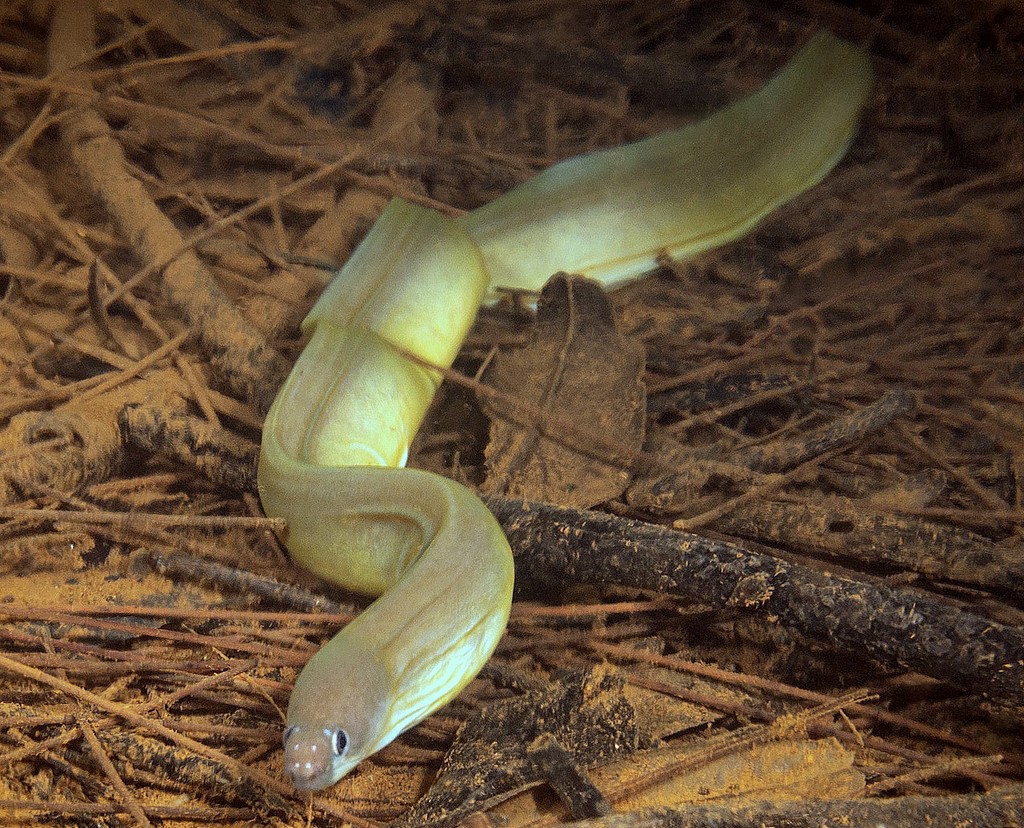ECHIDNA RHODOCHILUS - (BLEEKER, 1863)
Picture courtesy of: Damien Brouste
Actinopterygii (Gigaclass) > Actinopteri (Class) > Teleostei (Subclass) > Elopomorpha (Superorder) > Anguilliformes (Order) > Muraenoidei (Suborder) > Muraenidae (Family) > Muraeninae (Subfamily) > Echidna (Genus)
Murène aux lèvres roses, Pink-lipped moray eel, Namida Kawatsubo, ナミダカワウツボ, 玫唇蝮鯙,
Synonyme
Muraena rhodochilus (Bleeker, 1863)
----------------------------
Description
Predorsal vertebrae: 14, preanal vertebrae: 54, total vertebrae: 121. Body slender, head short, anus slightly anterior to mid point of body. Fins moderately high and concealed by thick skin. Dorsal fin origin posterior to gill opening and anal fin origin immediately behind anus. Gill opening elliptical, below lateral midline, larger than eye in diameter. Eyes above mid jaw and moderate in size. Snout blunt. Jaws subequal, upper jaw slightly longer; Teeth not visible when mouth closed. Anterior nostril at tip of snout, about eye radius in length. Posterior nostril above and sl ightly anterior to anterior margin of eye; As a round hole with slightly raised rim. Three supraorbital pores, all along front margin of snout. Four infraorbital pores along upper jaw (third & fourth pores inside of white blotch). Six preoperculo mandibular pores along lower jaw (anterior to corner of mouth). One branchial pore above and anterior to gill opening. Teeth stout, bluntly conical, with smooth edges. Intermaxillary tee th in five rows: two rows of 8 (left side) and 11 (right side) small, peripheral intermaxillary teeth; Two rows of 3-4 intermediate intermaxillary teeth; And one row of three large, median intermaxillary teeth. Maxillary teeth biserial, 19 and 16 smaller teeth on outer row decreasing in size posteriorly; 12 and 11 teeth on inner row, longer and pointier than outer teeth. Vomerine teeth uniserial, with 12 teeth decreasing in size posteriorly. Dentary teeth biserial anteriorly, uniserial posteriorly, with 4 and 5 larger and spaced teeth on inner row flanked by 23 and 18 smaller outer teeth. Some small teeth in space between larger teeth on outer maxillary and outer dentary. Max. length: 33.8 cm TL. Depth range: 0 - 10m
Color
Uniformly dark brown, with conspicuous white blotches around corn er of mouth. Head pores with white rims. Inner skin of posterior nostril, gill opening, and oral cavity whitish. Preserved color not significantly different to when fresh. Body covered with fluorescent green mucus when alive.
Etymology
Echidna: from Latin, echidna = viper or adder. Referring to serpentine shape.
rhodochilus: from Greek, rhódon = rose + from Greek, cheī́los = lip. Referring to pink upper and lower lips.
Original description: Echidna rhodochilus Bleeker, 1863 - Type locality: Roti Island (Nusa Tenggara Timur, Indonesia).
Distribution
Eastern Indian Ocean, western Pacific: eastern Indonesia, Philippines, Taiwan and New Caledonia.
Biology
Live in brackish water.
Last update: 5, June 2024
Actinopterygii (Gigaclass) > Actinopteri (Class) > Teleostei (Subclass) > Elopomorpha (Superorder) > Anguilliformes (Order) > Muraenoidei (Suborder) > Muraenidae (Family) > Muraeninae (Subfamily) > Echidna (Genus)
Murène aux lèvres roses, Pink-lipped moray eel, Namida Kawatsubo, ナミダカワウツボ, 玫唇蝮鯙,
Synonyme
Muraena rhodochilus (Bleeker, 1863)
----------------------------
Description
Predorsal vertebrae: 14, preanal vertebrae: 54, total vertebrae: 121. Body slender, head short, anus slightly anterior to mid point of body. Fins moderately high and concealed by thick skin. Dorsal fin origin posterior to gill opening and anal fin origin immediately behind anus. Gill opening elliptical, below lateral midline, larger than eye in diameter. Eyes above mid jaw and moderate in size. Snout blunt. Jaws subequal, upper jaw slightly longer; Teeth not visible when mouth closed. Anterior nostril at tip of snout, about eye radius in length. Posterior nostril above and sl ightly anterior to anterior margin of eye; As a round hole with slightly raised rim. Three supraorbital pores, all along front margin of snout. Four infraorbital pores along upper jaw (third & fourth pores inside of white blotch). Six preoperculo mandibular pores along lower jaw (anterior to corner of mouth). One branchial pore above and anterior to gill opening. Teeth stout, bluntly conical, with smooth edges. Intermaxillary tee th in five rows: two rows of 8 (left side) and 11 (right side) small, peripheral intermaxillary teeth; Two rows of 3-4 intermediate intermaxillary teeth; And one row of three large, median intermaxillary teeth. Maxillary teeth biserial, 19 and 16 smaller teeth on outer row decreasing in size posteriorly; 12 and 11 teeth on inner row, longer and pointier than outer teeth. Vomerine teeth uniserial, with 12 teeth decreasing in size posteriorly. Dentary teeth biserial anteriorly, uniserial posteriorly, with 4 and 5 larger and spaced teeth on inner row flanked by 23 and 18 smaller outer teeth. Some small teeth in space between larger teeth on outer maxillary and outer dentary. Max. length: 33.8 cm TL. Depth range: 0 - 10m
Color
Uniformly dark brown, with conspicuous white blotches around corn er of mouth. Head pores with white rims. Inner skin of posterior nostril, gill opening, and oral cavity whitish. Preserved color not significantly different to when fresh. Body covered with fluorescent green mucus when alive.
Etymology
Echidna: from Latin, echidna = viper or adder. Referring to serpentine shape.
rhodochilus: from Greek, rhódon = rose + from Greek, cheī́los = lip. Referring to pink upper and lower lips.
Original description: Echidna rhodochilus Bleeker, 1863 - Type locality: Roti Island (Nusa Tenggara Timur, Indonesia).
Distribution
Eastern Indian Ocean, western Pacific: eastern Indonesia, Philippines, Taiwan and New Caledonia.
Biology
Live in brackish water.
Last update: 5, June 2024
